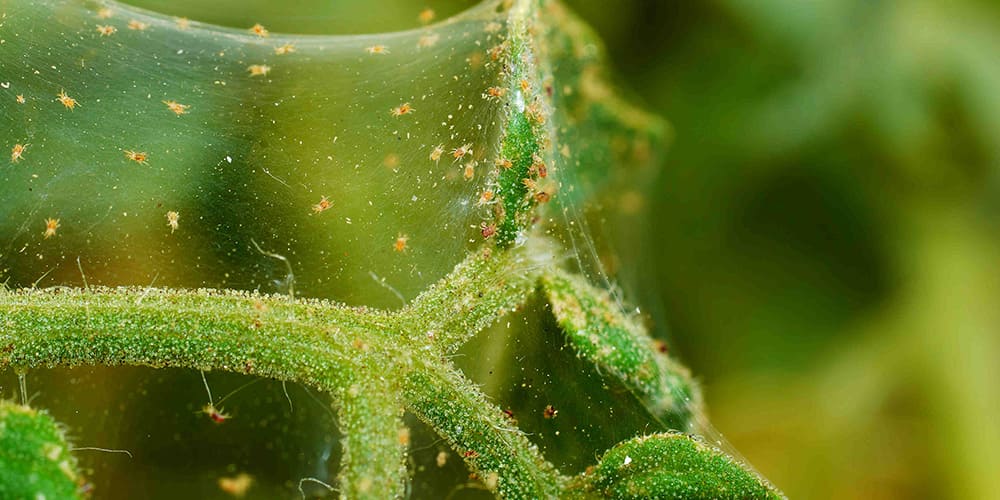How to Eradicate Spider Mites from Cannabis Effectively?

Navigating the world of cannabis cultivation offers an array of challenges, one of the most stealthy and persistent being the dreaded spider mite. These minuscule creatures, with their penchant for causing significant harm to plants, often escape detection until it’s too late.
This comprehensive guide delves into understanding these elusive pests, identifying the signs of their destructive presence, and provides eco-friendly solutions to manage and prevent their infestations. Whether you’re a seasoned grower or a novice, arm yourself with this knowledge to ensure your cannabis plants remain vibrant and mite-free.
Are you interested in cannabis cultivation? Then we have collected articles on this topic especially for you. You can read them here:
What Are Spider Mites?

Tiny mite mariners, barely a speck at less than 1 mm, hungrily plunder a myriad of verdant hosts. Thriving in balmy, radiant niches, these pests haunt the dreams of those nurturing cannabis in indoor sanctuaries and greenhouses.
They hide in the cool embrace of foliage, their color palette ranging from earthy amber to translucent pearl. Their gossamer eggs birth a new generation every trio of days, signaling a relentless cycle of appetite.
Spanning a mere fortnight, their existence weaves through stages: delicate orbs, inquisitive grubs, eager juveniles, and the seasoned forager.
Understanding their cyclical dance is a grower’s lifeline. An untamed mite brigade can drain cannabis of its lush vigor, compromising its essence and fragrant allure.
Descendants of the mysterious Tetranychidae lineage, they drain the plant’s vital nectar, casting shadows of decay. In a display of nature’s craft, they spin intricate tapestries of silk across their green domain, shielding their kin—a testament to their spider-inspired namesake.
Overlooked, their colonies swell with urgency. Their silk bastions become the silent guardians of hidden progeny. In the heart of blossoms, their interwoven threads pose a quiet threat.
Immerse yourself in the sensory delights of APE mini joints, thoughtfully infused with kief and dusted with sugar diamonds. APE Premium Cannabis Corp has handpicked a variety of strains to cater to your every craving – from the tranquility of indicas to the vigor of sativas.
What Does Spider Mite Damage Look Like?

Spider Mites wreak havoc in unique ways:
- Fine lacy webs wrapping plants
- Subtle sun-kissed or sand-toned blemishes on foliage
- Leaves bearing a sun-faded, bronze overlay
- Twisted petals and greenery
- Tiny ruby or ivory mobile dots across the surface
- Sparse white pinpoints scattered on the green canvas
- A sun-scorched appearance of the leaf
These mites, using their specialized mouthparts, latch onto the leaf’s belly, causing it to adopt a sun-bleached palette. When plants don webs, it’s a clear mite battleground. Effectively tackling them requires distinguishing their onslaught from mere dehydration.
You’ll spot muted beige, tan, or sunlit splotches on your green friends. The minuscule scarlet or alabaster movers? They’re the culprits. Soft gossamer threads may nestle beneath the leaves. A severe onslaught can cripple both decorative and vegetable plants.
Early signs are elusive white flecks atop the green, often escaping the untrained eye. In ideal conditions, such minor disruptions can spiral into an aggressive siege. As these tiny invaders feast, they drain the lifeblood of the plants.
This relentless assault leaves plants arid and shadowed. In time, leaves shrivel, revealing a weakened plant frame. Ignoring these minuscule warriors can seal the plant’s fate. On edible greens like melons and zucchinis, the chaos can lead to sun-streaked produce, early leaf detachment, and modest yields.
How to Get Rid of Spider Mites on Plants Naturally

Spotting spider mites early can make their management more straightforward. Here’s a nature-inspired toolkit for their removal:
- Utilize a plant-safe solution.
- Sprinkle outdoor-suitable mineral dust on plants.
- Introduce beneficial insects.
- Shower resilient, non-cannabis plants with a forceful water stream.
- For heavy infestations, consider removing the whole plant.
- Plant-friendly essential oils can incapacitate mites at a neural level.
In the face of a mite invasion, consistent application of a solution becomes key. It might take weeks to disrupt their lifecycle. For severe infestations, mix a concentrated solution with water and apply regularly.
Once the situation is under control, shift to a preventive ratio. Mites often create protective webs, so it’s recommended to remove these before spraying.
To hinder mite growth, coat the leaves with a culinary-grade mineral dust, causing mites to dehydrate and perish. As for nature’s solution, specific beneficial insects can be the answer. Ensure they’re suited for the current season. Options include helpful mites, ladybirds, pirate bugs, and various thrips, available at local nurseries.
For those who are interested in smoking weed, and not its cultivation, we recommend you to try APE Mini joints Bubble Gum.They also called “Bubba Gum” is an indica-dominant strain. Based on the name, it tastes like real chewing gum with a sweet aroma of flowers.
The strain will appeal to both beginners and experienced amateurs. Bubble Gum is uplifting and euphoric. The Bubble Gum strain is suitable for use at different times of the day.
And if you’re searching for a strain with potent indica effects, Crazy Berry is an excellent choice. This variety delivers a predominantly narcotic body high, making it an ideal choice for individuals seeking pain relief.
When smoked, you’ll notice sweet citrus flavors that are both delicious and long-lasting. Additionally, this strain has a strong berry scent that perfectly matches its potent high, making it a must-try for any cannabis connoisseur.
How to Prevent Spider Mites on Plants

Keeping spider mites at bay starts with preemptive action. The ambiance of your growing space holds the key. Aim for optimal balances in temperature, moisture, and ventilation. A heads up: temperatures exceeding 75°F catalyze rapid mite breeding. Embrace these strategies for seamless pest management:
- Set aside new plantings
Before merging fresh plantings with the rest, provide them 2-3 weeks of solitary adjustment.
- Ensure clean transitions
Switching between spaces? Thoroughly refresh your attire to avoid unintentional pest transfers.
- Conduct consistent checks
Embed systematic visual evaluations into your daily activities. Make it a point to scrutinize for intruders, turning to magnifying tools when needed. Throughout growth phases, focus especially on the leaf’s hidden sides.
- Maintain prescribed proportions
Trust in specialized agricultural solutions to tackle stubborn pests. Steer clear of unnecessary dilutions. At the first hint of trouble, act swiftly, sticking to the advised concentration.
In the intricate dance of cannabis cultivation, knowledge is your most powerful ally. Understanding spider mites, from their subtle signs of invasion to their natural adversaries, equips growers to preemptively act and protect their precious green investments.
As with all challenges in the world of horticulture, early detection and consistent preventive measures are the cornerstones of success.
By embracing the insights and strategies outlined in this guide, you’ll not only ensure the health and vitality of your plants but also secure the fruits of your labor, ensuring a bountiful and high-quality yield.















